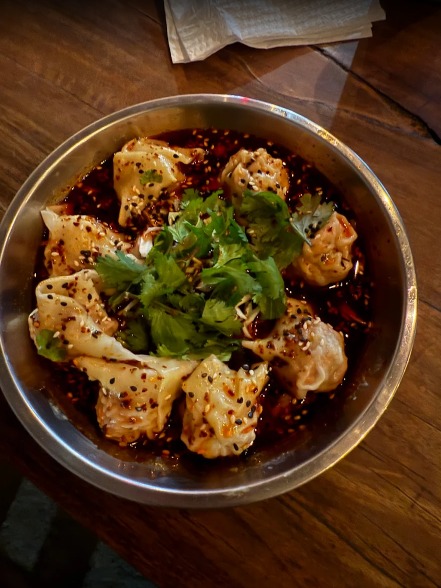Potato and rye bread, seaweed butter, oyster and borage leaves
There is no fish, no seafood and yet it is a wave of briny flavours on a crisp and moist toast.
Serves 4
For the bread
potatoes 300g
salt ½ tsp
yeast 1 tsp
sugar 2 pinches
plain flour 150g
rye flour 75g
rolled oats 30g
For the seaweed butter
seaweed (sea lettuce and Channel wrack, available online) 30g
butter 80g
shallots 1, finely chopped
lemon ½ tsp
Tabasco 3 drops
For the garnish
oyster leaves 8
borage 1 punnet
Make the bread. First peel the potatoes then wash and cut into 3cm chunks. Place in a small pan, cover with 2cm of water and ½ tsp salt. Bring to the boil, then lower the heat to simmer for about 15 minutes or until the potatoes are cooked.
Drain the potatoes in a colander saving 60ml of the potato water and keep aside both to cool. Add the yeast to the potato water with the sugar and mix to dissolve, then add 1 tablespoon of the white flour. Mix well with a whisk. Cover this yeast starter with clingfilm and leave to rise in a warm area to double in volume.
In a mixer with a paddle, break down the potatoes for 30 seconds then change to the hook, add the white and rye flour, the yeast starter and salt. Put on slow gear to start then increase the speed to mix it well - it will give a fairly dry dough. Stop the mixer and place the dough on the work surface.
Preheat oven at 220C/gas mark 7.
Knead the dough with the palm of your hand for 10 minutes. The dough will become wetter as you work it. Dust with some flour, a little at a time to stop the dough sticking to your hands and the work surface. After 10 minutes it should be quite elastic. Stretch a bit of dough to test it.
Shape a ball with the dough, dust with flour, then wrap loosely in a clean cloth and place in a warm area for about 45 minutes. The dough will nearly double in size.
Place the dough on a lightly floured surface and sprinkle with the rolled oats. With the palm of your hand, gently flatten to form a rectangle 30 x 20cm. Fold down from the top the first 3-4cm and seal along the line with your finger to gently seal it all along. Repeat this twice and then for the last one (fourth), seal along the seam of what is now a log shape. Place the log on a floured thin baking tray in a warm area. Cover with a cloth and leave for 45 minutes. The dough will rise and will feel soft and spongy when touched.
Cook in the hot oven for 45 minutes, reducing the temperature to 180C/gas mark 4 after 20 minutes. Spray with water every 5 minutes. Rest at least 30 minutes before slicing.
To make the seaweed butter, plunge the seaweed in boiling water then drain, refresh and chop finely. Mix with all the ingredients for the butter.
Cut 4 slices of bread, lightly toast then allow to cool slightly before spreading with the seaweed butter. Stick the oyster leaves and borage in to look like they are sprouting from the toast. Serve immediately.
Peach, watermelon and basil salad with salmon confit
I have been using this technique of compressing watermelon for quite a few years now because I love the flavour and texture it achieves. The refreshing sweet and savoury flavours make it a perfect summer dish.
Serves 4
fillet of salmon 320g
olive oil
salt and pepper
thick watermelon slice, skin on 400g
toasted fennel seeds ½ tsp, crushed
fresh ripe peaches 2
Greek basil, picked 2 tbsp
For the dressing
olive oil 4 tbsp
lime juice 1 tsp
lemon juice 1 tbsp
elderflower cordial 2 tsp
salt and pepper
Brush the salmon with olive oil and season with salt and pepper. Lay in a small oven dish, skin-side down, and place in oven at 80C for 15 minutes. I think salmon tastes better if it is not completely cooked through to the centre, so check after 15 minutes and if cooked enough, remove and leave to rest. Once out of the oven, cover with clingfilm that's been pierced with a few holes, and leave to cool.
Next, remove the skin and the white part around the slice of watermelon. Season with salt on both sides and sprinkle with the fennel seeds, also on both sides. At the restaurant, we vacuum pack the watermelon to extract the air which gives the flesh a wonderfully different texture. This result can be closely achieved by squeezing the slice of watermelon between two sheets of clingfilm with a plate on top and a weight to push it down. Leave for at least 20 minutes.
To make the dressing, mix all the ingredients in a small bowl with a little whisk and check the seasoning.
Finally, wash the peaches under cold running water then cut each one into 8 slices. Flake the salmon. Cube the watermelon and divide between the plates with the peaches and the salmon. Sprinkle the basil leaves over the top then, with a spoon, drizzle the dressing over each plate before seasoning with a crack of freshly ground black pepper.
Padron peppers, almonds, black olive oil and salt cod
The story goes that for every 20 peppers there is a hot one in there. By the end of the summer it's more like five out of 20. Clean Spanish flavours in harmony on one plate.
Serves 4
salt cod (bacalao) 100g
thick fillet of fresh cod 400g
pitted black olives in oil 100g
olive oil (for black olive oil) 150ml plus 2 tbsp
padron peppers 24
sea salt
whole peeled almonds 20, lightly toasted
pepper a grind
The night before, take the uncooked bacalao and shred with a fork. This mixture will be used as a flavouring, so if you get a lot, put it in an airtight container and keep in the fridge for at least a month to use later in another dish or freeze. Place the piece of fresh cod on a large sheet of clingfilm skin-side down and cover the top (flesh side) with a thin layer of the bacalao. Wrap tightly then place on a plate, skin-side down to lightly cure overnight.
On the day, wash the black olives in a colander under cold running water then lay them on a cloth and pat dry.
Line an ovenproof metal tray with greaseproof paper and top with the olives. Place in oven at 100C/gas mark ¼ for about 2 hours or until the olives feel hard between two fingers.
In a blender, process the olive oil and the dried olives until completely smooth. At this stage the olive oil will be dark black and really concentrated in olive flavours. Pour into a squeezable plastic bottle and place in the fridge.
About 30 minutes before eating, remove the cod from the clingfilm and scrape off the salt cod. Heat a small frying pan with a bit of olive oil then place the cod skin-side down and cook on a medium heat for a minute then place in the oven at 180C/gas mark 4 for about 5 minutes, remove from the heat and keep aside covered with foil.
In a frying pan, heat a film of olive oil and fry the peppers, turning them from time to time for about 2 minutes. Once cooked sprinkle with salt.
Scatter the peppers on the plates, then flake the cod and arrange around the peppers. Scatter the toasted almonds (these can be toasted in advance in a dry pan), then gently squeeze a drizzle of black olive oil between the ingredients on the plate.
Corn and quinoa tamale, salsa and glazed belly pork
I've become a bit obsessed with cooking in leaves as they protect the food from the direct heat but help retain the moisture and flavours.
Serves 4
pork belly 300g
vegetable oil 2 tbsp
salt and pepper
For the glaze
Worcestershire sauce 1 tbsp
tomato ketchup 2 tbsp
honey 1 tbsp
red wine vinegar 1 tbsp
salt and pepper
HP sauce 1 tbsp
tomato paste 1 tsp
orange 1 slice
For the tamale
corn on the cob with husk 4
olive oil 4 tbsp
medium brown onion 1, finely chopped
garlic 3 cloves, finely chopped
lemon thyme ½ tsp
dried chipotle chilli 1 tsp, finely chopped
apple juice 200ml
quinoa 1 heaped tbsp
For the salsa
red pepper ½
small red onion ¼
tomato 1
cucumber 5cm chunks
olive oil 3 tbsp
garlic ½ clove
lime ½, juiced
Preheat the oven at 220C/gas mark 7. Rub the pork belly with oil, season with salt and black pepper and place it in a small oven dish, skin-side up in the hot oven for 10 minutes.
To make the glaze, in a dish mix together all of the ingredients for the glaze along with 100ml water and pour over the pork belly. Roll the belly in the glaze mixture to get an even coating, cover in foil and lower the oven temperature to 150C/gas mark 2. Cook for 30 minutes, turning the pork belly every 5 minutes, coating it well with the sauce each time. Keep covered with the foil to avoid the pork drying out. If it is a thick piece of pork over 4cm, it will need a further 10 minutes.
To make the tamale, gently pull off the husk from the cob, making sure to keep it whole. With a sharp knife, cut the corn from the cob and keep the husk to one side.
In a pan, heat up the olive oil and add the onion, garlic, lemon thyme and finely chopped chipotle. Cook by gently stirring until the onions are a light golden colour - at this stage add the corn and apple juice. Cover with a lid and gently simmer on a low heat.
After 15 minutes, keeping the ingredients in the pan, use a hand blender to pulp three or four times - start to break some corn and release some of the starch. Add the quinoa, mix well, cover with a lid and cook on a low heat for another 10 minutes. Pour the mix into a fresh bowl, then leave to cool.
To shape the tamale, on a work surface overlap the cob leaves to make four crosses. Place equal amounts of the mixture in the middle and then fold in the right side to the left, then the top down towards you, then the left to the right, and finally the front up to complete the parcel. Tighten each parcel neatly with a piece of string.
To make the salsa, toss the red pepper, red onion, tomato and cucumber in very little olive oil, season with salt and pepper then sear them on a very hot cast iron griddle to get nice black stripes. Place in a blender, add the olive oil, salt, pepper, garlic and lime juice - blend until very fine and test the seasoning.
Place the tamale on the cast-iron griddle to colour on both sides. Switch off the heat and leave on the griddle to let the inside of the tamale warm. Cut the pork belly into four. On each plate, place the tamale with a small piece of pork belly and the salsa (serve it in a jug). Cut off the top leaves of the tamale with scissors and serve.
Asparagus, aubergine and miso puree with fried onions
I love the classic way of serving asparagus dipped in a soft-boiled egg, and I think that the rich creaminess of the egg is echoed here with the aubergine and miso purée.
Serves 4
English asparagus 16
olive oil 2 tbsp
For the aubergine and miso purée
aubergine 1 medium
lemon ½, juiced
pepper
white miso purée (from supermarkets) 2 tbsp
olive oil 30ml
For the fried onions
brown onion 1, keep whole and slice
salt
vegetable oil for deep frying
flour 2 tbsp
nasturtium leaves 20 (or watercress for the peppery flavour)
Preheat the oven to 200C/gas mark 6. To prepare the onions, separate the rings from the slices, place on a plate, sprinkle with salt and put to one side.
Cut the aubergine in half lengthways, and score the flesh with a knife. Rub with the lemon juice, season with pepper, drizzle with a little olive oil and wrap in a large piece of foil. Place on a dish in the preheated oven for 20-25 minutes. Remove from the oven and leave in the foil to cool down.
Open the foil over a bowl to make sure you catch all the juices, place the aubergine flat on a plate and spoon out the cooked flesh, putting the skin to one side. Place the flesh in a bowl with the juices and add the miso purée, then place all the ingredients in a blender, add the remaining 30ml olive oil, and blend to form a smooth purée. Season - a bit of lemon juice may be needed.
Trim any hard ends from the asparagus if necessary, roll in 2 tablespoons of olive oil, season with salt and pepper and leave to marinade for 10 minutes. I cook them directly on a flat top grill (plancha). Grill both sides for 90 seconds each, then spread them out on a dish - do not place them on top of each other as they will continue to cook.
Meanwhile, heat up a large pan with vegetable oil, 2cm deep. Pat dry the onion rings, toss them in flour and deep fry until golden and crisp - place on kitchen paper to absorb excess oil.
To finish, spread the purée equally on the four plates, arrange the asparagus with the onion rings and finish with the nasturtium leaves (or watercress).
Chilled lobster Bloody Mary
The way this dish is served brings theatre to the table and the intense flavours of the tomato water, the rich lobster followed by a nice kick of vodka really works.
Serves 4
heritage tomatoes 200g, at room temperature
lobster 1, about 500g
salt and pepper
extra-virgin olive oil 2 tsp
sherry vinegar ½ tsp
Greek basil, picked 1 tbsp
For the tomato water
good, ripe vine tomatoes 600g
celery 1 stick
basil about 6 leaves
sugar ⅓ tsp
sherry vinegar 1 tsp
fennel tops 1 tsp, chopped
freshly grated horseradish 1 tsp
salt and pepper
vodka 4 tbsp (or to taste)
ice cubes 3
Make sure the heritage tomatoes are at room temperature.
To make the tomato water, quarter the vine tomatoes and add to the blender with the celery stick, basil, sugar, sherry vinegar, fennel tops, horseradish, salt and pepper. Liquidise until smooth, then pour into a muslin cloth, in a sieve, over a bowl. Close the muslin tightly with a piece of string and leave over the bowl for the liquid to slowly drip through. After half an hour, put a small plate over the muslin parcel and place a 1 kg weight on top to help compress the juice. Check the seasoning and set aside.
Bring a large pan with 2 litres of water to the boil and add 1 tablespoon of salt. Plunge the lobster in the pan and hold it down with a spoon, return to the boil then lower the heat to a simmer and cook the lobster for 8 minutes, switch off the heat and leave for 2 minutes. Lift the lobster out of the water with tongs and plunge in cold water for a minute, then drain in a colander.
After 10-15 minutes when the lobster is cool, crack it open, remove the meat and cut into circular medallions. Place in a bowl with the sliced heritage tomatoes, dress with a touch of olive oil and sherry vinegar. Toss well and serve equal amounts in the middle of each bowl. Top with Greek basil.
Pour 380ml of the tomato water in a shaker, add the vodka and 3 ice cubes. Place the bowl in front of your guest, shake the "cocktail" at the table and pour equally over each serving.
Chocolate brownie and pear tart
The way the poached pears contrast with the crumbly pastry and the slightly gooey brownie filling is really satisfying.
Makes 8 portions
For the poached pears
water 1 litre
sugar 250g
lemon juice of½
pears 8, whole and peeled
For the brownie filling
dark chocolate 185g
butter 185g
large eggs 3
light brown sugar 275g
cocoa powder 40g
white chocolate buttons 100g
For the pastry base
flour 240g
soft butter 180g
water 60ml
salt a pinch
You will also need
23cm tart tin
To cook the poached pears, place the water, sugar and lemon juice into a medium pan and bring to the boil to dissolve the sugar. Place the whole, peeled pears in a pan with enough syrup to cover them before adding a piece of greaseproof paper (with a hole in the middle to allow the steam to escape). Bring to the boil, simmer for 10 minutes or until the pears are tender. Cool in the syrup.
To make the brownie, melt the dark chocolate and butter over a bain-marie. Place the eggs and sugar in a bowl and whisk until white and fluffy, then pour the melted chocolate mixture over. Next add the cocoa powder and fold in with a plastic spatula. Add the white chocolate buttons and mix. Set aside.
To make the pastry, place the flour on a work surface. Make a well in the centre and add the salt and soft butter. Slowly bring the flour into the centre and mix with your fingertips to a crumbly texture. Then add water and work the dough with the palms of your hands till smooth. Wrap in clingfilm and place in fridge for 30 minutes.
Once the pastry is chilled, roll out the dough to 4mm thick and line the tart tin, making sure all the sides are pressed in so it sticks against the side eliminating any air bubbles. Leave a slight overhang all around the tin and blind bake at 200C/gas mark 6 with baking beans, till a lovely golden colour.
Remove the beans and spoon in the chocolate mix. Cut the pear in two, across the middle, so you have a top and bottom section and push the eight tops around the outside of the tart. Next, core out the middle of the bottom sections and cut into two pieces. As you will have too much pear you will only want to use half of the bottom pear sections for this recipe. Cut in two again before adding to the centre of the tart and between the tops.
Reduce the oven temperature to 180C/gas mark 4. Bake for 20-25 minutes or less if you like it gooey in the middle.
Chocolate brownie and pear tart. Photograph: Jonathan Lovekin













